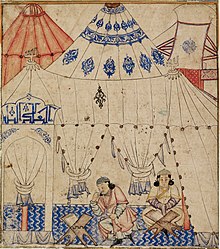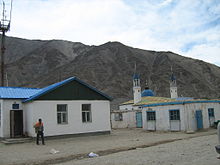Islam in Mongolia
| Islam by country |
|---|
 |
|
|




Islam in Mongolia is practiced by approximately 5% of the population.[1] It is practised by the ethnic Kazakhs of Bayan-Ölgii Province (88.7% of total aimag population) and Khovd Province (11.5% of total aimag population, living primarily in the Khovd city, Khovd sum and Buyant sum) aimag in western Mongolia. In addition, a number of small Kazakh communities can be found in various cities and towns spread throughout the country.
History
The earliest evidence of Islam in Mongolia is dated to 1254, when the Franciscan William of Rubruck visited the court of the great khan Mongka at Karakorum. He celebrated Easter at a Nestorian Christian church but also noted seven temples of the "idolators" (probably Buddhist and Taoist temples), and two mosques. Therefore, historians date the arrival of Islam to Mongolia to between 1222 and 1254. Islam also gained the notice of the Mongols, after Genghis Khan had conquered Afghanistan. In 1222 he, on his way back to Mongolia, visited Bukhara in Transoxiana. It was believed he inquired about Islam, and subsequently approved of Muslim tenets except the Hajj, considering it unnecessary. Nevertheless, he continued his worship of Tengri as his ancestors had done.
Genghis Khan's grandson Berke converted to Islam due to the efforts of Saif ud-Din Dervish, a dervish from Khorazm, thus Berke became one of the first Mongol rulers to convert. Other Mongol leaders owed their conversion to Islam due to the influence of a Muslim wife.[2] Later, it was the Mamluk ruler Baibars who played an important role in bringing many Golden Horde Mongols to Islam. Baibars developed strong ties with the Mongols of the Golden Horde and took steps for the Golden Horde Mongols to travel to Egypt. The arrival of the Golden Horde Mongols to Egypt resulted in a significant number of Mongols accepting Islam.[2] By AD 1330s three of the four major khanates of the Mongol Empire had become Muslim.[3] These were the Golden Horde, Hulagu's Ulus and Chagatai's Ulus. The Yuan Empire also embraced Muslim peoples such as the Uyghurs and Persians.
Although the court of the Yuan Empire adopted Tibetan Buddhism as the official religion, the majority of the ordinary Mongols, especially those who continued living in Mongolia proper remained Shamanists. After the decline of the Yuan Dynasty, Shamanism once again became the dominant religion. To varying degrees, political and economic relations with Muslim nations such as Moghulistan and the Uyghurs continued.
The Muslim Kazakhs began to settle in the Jungaria and Altai regions since the late nineteenth century. The majority of these Kazakhs were the Kerei and Naiman clans, many of them escaping persecution from Czarist Russia. When Bogdo Khan assumed power in Mongolia on December 29, 1911, the Kazakhs in Xinjian and Altai regions sought patronage of the restored Khanate. The Government of Bogdo Khan admitted them and allowed them to settle in the western region of Mongolia's Kobdo territory.
Communist era
Bayan-Ölgii aimag was established as part of the administrative reforms of the Mongolian People's Republic in 1940. As a result of historically high birth rates, the Muslim population in Mongolia increased between 1956-1989. However, there was a decline in the Muslim population [4][5] in 1990-1993 due to the large wave of repatriation of ethnic Kazakhs (so called oralmans) to Kazakhstan following the break-up of the Soviet Union. Islam is freely practised in the country since Mongolia became a democracy in 1990.
Today
Islam is currently practiced predominately in the western portion of the country as well as in Mongolia's capital. Some of the major population centers with a significant Muslim presence include Ulan Bator (90% in khoroo #4 of Nalaikh düüreg[6]), Töv and Selenge aimags, Erdenet, Darkhan, Bulgan, Sharyngol (17.1% of population total[7]) and Berkh cities.
| 1956 | % | 1963 | % | 1969 | % | 1979 | % | 1989 | % | 2000 | % | 2007[9] | % |
|---|---|---|---|---|---|---|---|---|---|---|---|---|---|
| 36,729 | 4.34 | 47,735 | 4.69 | 62,812 | 5.29 | 84,305 | 5.48 | 120,506 | 6.06 | 102,983 | 4.35 | 140,152 | 5.39 |
Notable Mongol Muslims

- Berke - grandson of Genghis Khan and leader of the Golden Horde who was the first Mongol ruler to establish Islam in a Mongol state.[10]
- Mahmud Ghazan - seventh ruler of the Ilkhanate.[11]
- Muhammad Khodabandeh - formerly a Christian, he was the eighth Ilkhanid dynasty ruler in Iran from 1304 to 1316.[12]
- Mubarak Shah - head of the ulus of the Chagatai Khanate (1252–1260, March-September 1266).[13]
- Nawrūz (Mongol emir) - a convert to Islam;[14] he played an important role in the politics of the Mongol Ilkhanate.
- Negudar - Mongol general and noyan[15]
- Nogai Khan - Mongol general and great-grandson of Genghis Khan.[16]
- Tarmashirin - Khan of the Chagatai Khanate following Duwa Timur.
- Tekuder - Mongol leader of the Ilkhan empire who was formerly a Nestorian Christian.[17]
- Tuda Mengu - Mongol leader of the Golden Horde[18]
- Tughlugh Timur - the Khan of Moghulistan.[19]
Notes
- ^ Muslim Population Pewforum
- ^ a b Arnold, Thomas Walker, The Preaching of Islam: a history of the propagation of the Muslim faith. Lahore: Sh. Muhammad Ashraf, 1896; pp. 192, 334
- ^ The Encyclopedia Americana, by Grolier Incorporated, p. 680
- ^ US State department: Mongolia background note
- ^ CIA: The World Factbook
- ^ Education of Kazakh children: a situation analysis. Save the Children UK, 2006
- ^ Sharyngol city review [1]
- ^ "Монгол улсын ястангуудын тоо, байршилд гарч буй өөрчлөлтyyдийн асуудалд" М. Баянтөр, Г. Нямдаваа, З. Баярмаа pp.57-70
- ^ State Center for Civil Registration and Information
- ^ De Weese, Devin A. Islamization and Native Religion in the Golden Horde, Penn State Press, 1 Sep 1994, ISBN 0-271-01073-8; p. 3
- ^ Mahmud Ghazan. Encyclopædia Britannica. 2007. Britannica Concise Encyclopedia. 2 July 2007.
- ^ Limbert, J. W. (2004). Shiraz in the Age of Hafez: the glory of a medieval Persian city. Seattle: University of Washington Press. p. 87
- ^ Keene, H. G. A Sketch of the History of Hindustan from the First Muslim Conquest to the Fall of the Mughol Empire, London : W. H. Allen & Co., 1885
- ^ Khanbaghi, Aptin The Fire, the Star and the Cross: minority religions in medieval and early modern Iran. London: I. B. Tauris, 2005 ISBN 1-84511-056-0; pp. 69-70
- ^ The Biographical Dictionary of the Society for the Diffusion of Useful Knowledge. 4 vols. London, 1842-1844. p. 226
- ^ Vásáry, p. 71
- ^ Runciman, Steven A History of the Crusades. 3 vols. Cambridge University Press, 1951-1954, p. 397
- ^ Martin, Janet Medieval Russia, 980-1584: 980-1584. Cambridge: Cambridge University Press, 1995; p. 171
- ^ Newman, Andrew J., ed. Society and Culture in the Early Modern Middle East. Leiden: Brill, 2003 ISBN 90-04-12774-7; p. 30

